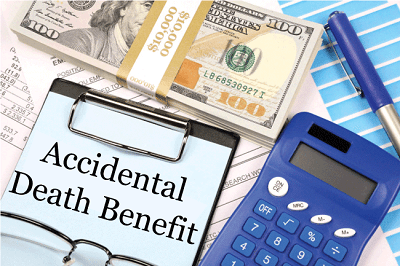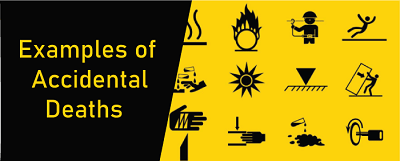Accidental Death BenefitWhat exactly is an Accidental Death Benefit?An accidental death benefit is a sum given to the beneficiary of an accidental death insurance policy, which is often coupled with a life insurance policy as riders, clauses, or add-ons. Suppose the insured dies as a result of natural causes. In that case, the life insurance policy's accidental death benefit (ADB) normally pays in addition to the associated standard benefits. 
Suppose the insured dies due to the accident. In that case, the policy issuer may sometimes pay an accidental death benefit up to a year after the occurrence. In-Depth Understanding of Accidental Death BenefitAccidental death benefits are add-ons, clauses, or riders that can be added to standard life insurance policies at the insured's request. Some policies even offer features to safeguard beneficiaries in the event of an accident. This is significant because accidents are difficult to predict and can result in financial difficulties for the family if the primary earner dies suddenly. Accidental death benefits are critical for individuals who work in or near potentially hazardous environments. Even individuals, who drive more than normal, whether professionally or as commuting drivers, should think about signing in for an accidental death benefit plan. The insured must pay an additional cost on top of their regular premiums to acquire this benefit as an optional feature. The accidental death benefit then boosts the payout to the policy's beneficiary. In essence, the beneficiary receives the standard death benefit of the policy as well as any extra accidental death benefit which was added by the insured person. However, these policies often expire when the insured exceeds the specified age, such as 60, 70, or 80. What constitutes Accidental Death?Insurance companies describe it as an incident that occurs entirely as a direct result of an accident. Car accidents, slips, choking, drowning, machinery, and other unforeseen events are examples of accidental fatalities. In most cases, death must occur within the time limit provided in the policy. Accidental death benefit plans can also cover dismemberment (limb loss, total or partial), burns, paralysis, and other related ailments. They are known as AD&D (accidental death and dismemberment) riders. HistoryIn the nineteenth century, the concept of the accidental death benefit or accident insurance was developed. The steam engine was invented at this time, and transportation evolved significantly. Railroads were rapidly expanding across England at the time, but the speed of the expansion left little room for safety. As a result, the number of rail accidents and deaths increased, prompting the country to produce accidental death insurance. When an American architect, James G. Batterson, introduced this idea from England, it gradually moved west to the U.S.A. Batterson established the now-famous Travelers Insurance Company in 1863. The company developed several new insurance products, including vehicle insurance, flying insurance, and even space trip insurance for astronauts. What are the types of Accidental Death Benefit Plans?Group Life SupplementIt is part of a group life insurance plan that includes an accidental death benefit plan like the one many employers offer. Often, the amount is similar to the group life benefit amount. VoluntaryA voluntary accidental death benefit plan is a separate, elective benefit for a group of members. If the company offers them, premiums are the individual's responsibility; these payments are collected from their paycheck regularly. In this, employees are covered in the case of a workplace accident. Even if the insured person is not working, benefits for voluntary accident insurance are offered. Travel AccidentIt is generally offered as part of an employee benefit plan. It offers workers additional accident protection when they are on corporate business. Unlike voluntary accident insurance, the entire premium for this coverage is paid by the employer. DependentsSome accidental death benefit plans provide coverage for dependents. Consider the following scenario: a person who has a spouse, partner, or children who rely on the person's salary to pay bills and other expenditures. In that case, a person should consider enrolling in an accidental death benefit. This additional insurance could assist dependents by offering money to pay bills, paying off a mortgage, or providing funds to their children for future events such as college. Furthermore, if an individual co-owns a business with another person, the business partner may be listed on the insurance policy to cover any outstanding debts if the insured dies. Insurance ContractsAccidental death and dismemberment (AD&D) is very much a legal issue. Even with the numerous judicial precedents established to clarify the claims procedure, the common law around AD&D insurance continues to change. Many legal nuances are related to processing an accidental death claim. When the claims of the insurer and the insured differ on the nature of the accident, some common laws developed are imposed to deal with such issues. A few of the causes are described below: 1. Proximate CauseIt is intended to identify an accident as the prime reason for death or injury. It can be interpreted in two ways. Firstly, suppose the accident was caused by a pre-existing condition, such as a sickness. In that case, the insured may be denied coverage. Secondly, even if the accident was caused by a pre-existing condition, the insured can receive the money if the accident led to the insured's death or injury. 2. SubstantialityIts objective is to explore how much the accident contributed to the insured's injury or death. Sometimes, a claim may be denied if the accident is proven to have contributed little towards death or injury. 3. Predominant CauseIt is similar to proximate cause, except the insurer must establish that the insured would have died from pre-existing problems even if the event had not occurred. The accident did not severely reduce the insured person's life. In most AD&D plans, the term "accidental death" is mentioned. It is frequently performed employing exclusionary contract terms. The clauses specify the basis on which the insurer believes the insured would be refused benefits. Examples of such exclusions include:
What constitutes Accidental Death in insurance terms?
It is defined by insurance companies as an occurrence that results in death as a consequence of an accident. For instance, most automobile accidents, falling down stairs, equipment or machinery accidents, suffocation, and even drowning are caused by circumstances beyond one's control and are therefore considered to be accidents. Are Accidental Death & Dismemberment Insurance and Accidental Death Benefit the same thing?Both accidental death & dismemberment (AD&D) and accidental death benefit (ADB) policies both pay a benefit. The primary distinction is that an AD&D policy will also pay if the insured is dismembered or injured. In contrast, ADB coverage will only pay if the insured dies. The Bottom LineThe accidental death benefit policy is best suited for individuals who work in dangerous settings or are prone to accidents. For them, an accidental death benefit rider is an excellent supplement to existing term insurance. Possessing this rider adds an extra layer of financial security to the family in the event of the insured's untimely death in an accident. To avoid unpleasant surprises, it is crucial to be informed of the terms and restrictions related to riders before incorporating them into the insurance policy. To purchase a term plan, one must first thoroughly assess their financial needs and lifestyle. Also, it is best to consult a professional before applying for any policy, be it life insurance or accidental death benefit add-on.
Next TopicAccommodative Monetary Policy
|
 For Videos Join Our Youtube Channel: Join Now
For Videos Join Our Youtube Channel: Join Now
Feedback
- Send your Feedback to [email protected]
Help Others, Please Share










